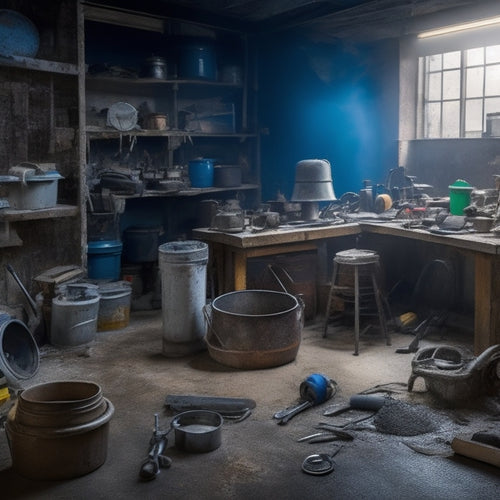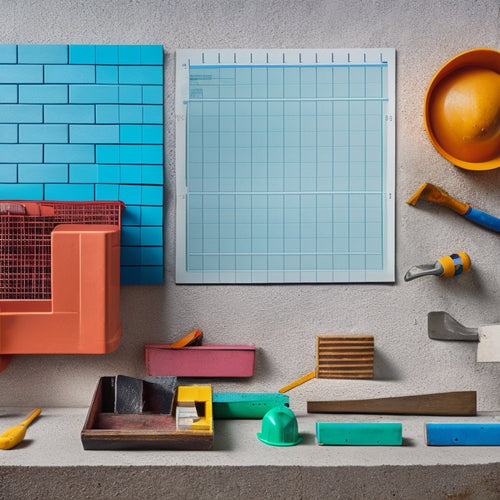
7 Essential Tools for Epoxy Concrete Crack Repair
Share
When you're tackling epoxy concrete crack repair, having the right tools can make all the difference between a successful repair and a costly redo. You'll need an epoxy injection gun that provides accurate delivery and control, as well as crack preparation tools like chisels, wire brushes, and vacuum systems to guarantee a clean surface. A reliable mixing tool with the right technique is also essential, along with a precision trowel that matches the crack width and depth. Additionally, you'll require effective concrete surface cleaners, epoxy dispensing nozzle tips, and advanced crack filling tools like diamond-coated saw blades. By arming yourself with these essentials, you'll be well-equipped to tackle even the most challenging repairs and guarantee a strong, lasting bond. With the right tools in hand, you'll be ready to take on the next step in the repair process.
Key Takeaways
• An epoxy injection gun is essential for accurate and controlled delivery of epoxy resin into cracks.
• Proper crack preparation tools, such as chisels, wire brushes, and vacuum systems, ensure a clean surface for strong bonding.
• Effective mixing tools and techniques, including mixing stick designs and strategies, ensure thorough and even epoxy mixing.
• A precision trowel with the right size, material, and blade angle is crucial for achieving a smooth and even epoxy finish.
• Advanced crack filling tools, such as diamond-coated saw blades and precision injection nozzles, can enhance epoxy flow and reduce material waste.
Epoxy Injection Gun Essentials
You'll need a reliable epoxy injection gun to accurately deliver the epoxy resin into the crack, guaranteeing a successful repair. This essential tool is responsible for injecting the epoxy resin into the crack, allowing it to flow smoothly and evenly.
When choosing an epoxy injection gun, look for one that's durable, easy to use, and provides precise control over the epoxy application techniques. This will make certain that the epoxy resin is delivered at the correct pressure and flow rate, resulting in a strong and lasting bond.
It's also vital to prioritize crack repair safety when working with epoxy injection guns. Always wear protective gear, including gloves, safety glasses, and a respirator, to prevent exposure to the epoxy resin and other hazardous materials.
Additionally, verify the work area is well-ventilated and free from any ignition sources. By following these guidelines and using a high-quality epoxy injection gun, you'll be able to achieve professional-grade results while maintaining a safe working environment.
Crack Preparation Tool Options
Preparing the crack surface is a critical step in guaranteeing a successful epoxy concrete repair, and selecting the right crack preparation tool options is essential for achieving a strong bond.
You'll want to choose tools that allow you to effectively employ crack assessment techniques and surface preparation methods.
Here are some essential crack preparation tool options to take into account:
-
Crack chisels: For removing loose debris and widening the crack to guarantee a strong bond.
-
Wire brushes: For cleaning the crack surface and removing dirt, oil, or other contaminants.
-
Vacuum systems: For removing dust and debris from the crack, guaranteeing a clean surface for the epoxy.
- Surface profiling tools: For creating a rough, textured surface that allows for a stronger bond between the epoxy and concrete.
Effective Mixing Stick Designs
When selecting a mixing stick for epoxy concrete crack repair, you'll want to take into account the material options that suit your needs, from durable stainless steel to lightweight fiberglass.
You'll also appreciate the importance of an ergonomic handle design that fits comfortably in your hand, reducing fatigue during extended mixing sessions.
Stick Material Options
Ideal epoxy concrete crack repair hinges on selecting the right mixing stick, and a key factor in this decision is the material composition of the stick itself.
As you choose a mixing stick, you'll want to evaluate the material's adhesive properties and how they impact the epoxy's curing times.
When it comes to stick material options, you have several choices:
-
Fiberglass sticks: These offer excellent durability and resistance to bending or breaking, making them ideal for heavy-duty repairs.
-
Carbon fiber sticks: Lightweight and incredibly strong, these sticks are perfect for larger repairs or when working in tight spaces.
-
Polypropylene sticks: A cost-effective option with good chemical resistance, these sticks are suitable for most general-purpose repairs.
- Stainless steel sticks: The most durable option, these sticks provide exceptional resistance to corrosion and are ideal for high-traffic areas or extreme environments.
Ergonomic Handle Design
You'll find that an ergonomic handle design greatly impacts the overall efficiency and comfort of your epoxy concrete crack repair process. A well-designed handle can reduce fatigue and discomfort, allowing you to focus on the task at hand.
When selecting a mixing stick, look for handles with contoured grips that fit comfortably in your hand. A non-slip grip texture is essential, as it prevents the stick from slipping out of your hand during vigorous mixing. Additionally, consider handles with cushioned grips or ergonomic curves that reduce pressure points.
A comfortable handle design also enables you to maintain a secure grip, even when working with thick or viscous epoxy materials. This is particularly important when mixing large quantities or working in confined spaces.
Mixing Pattern Strategies
To achieve a thorough and consistent mix, it's essential to employ a systematic mixing pattern with your epoxy concrete crack repair tool, leveraging the design of the mixing stick to guide your strokes. This will guarantee that you combine the resin and hardener in the correct material ratios, resulting in a strong and durable bond.
When it comes to mixing techniques, you'll want to focus on the following strategies:
-
Alternating strokes: Alternate between circular and figure-eight motions to guarantee thorough coverage of the mixing stick's surface.
-
Sweeping arcs: Use long, sweeping arcs to mix the material, starting from the center and working your way outwards.
-
Repeating patterns: Repeat a consistent pattern of strokes to maintain a uniform mix, avoiding any areas of unmixed material.
- Scraping the sides: Periodically scrape the sides and bottom of the mixing container to incorporate any unmixed material and prevent settling.
Precision Trowel Selection Guide
When selecting a precision trowel for epoxy concrete crack repair, you'll want to take into account three critical factors.
First, you'll need to choose a trowel size that's suitable for the crack's width and depth, ensuring ideal coverage and minimizing waste.
Next, you'll want to evaluate the ergonomic handle design to reduce fatigue and improve control, as well as the blade angle's impact on the finished surface.
Trowel Size Matters Most
Your epoxy concrete crack repair project's success hinges on selecting the right trowel size, which directly impacts the precision and quality of the repair. A trowel that's too large can lead to uneven epoxy distribution, while one that's too small can cause fatigue and slow down the repair process.
To guarantee a successful repair, consider the following factors when selecting a trowel:
-
Trowel thickness impact: A thicker trowel provides more control and is ideal for deeper cracks, while a thinner trowel is better suited for smaller, more precise applications.
-
Trowel material considerations: Choose a trowel made from high-quality, rust-resistant materials, such as stainless steel or fiberglass, to prevent contamination and guarantee durability.
-
Crack width and depth: Select a trowel that can accommodate the width and depth of the crack, guaranteeing even epoxy distribution and a smooth finish.
- User comfort and control: Opt for a trowel with an ergonomic design and comfortable grip, allowing for precise control and reduced fatigue during the repair process.
Ergonomic Handles Reduce Fatigue
A precision trowel with an ergonomic handle is essential for epoxy concrete crack repair, as it allows you to maintain control and precision while reducing fatigue during extended use.
When selecting a trowel, consider the handle materials that prioritize user comfort. Look for handles made from durable, yet lightweight materials such as fiberglass or aluminum, which reduce strain on your hand and wrist.
Additionally, ergonomic design features like contoured grips, finger rests, and cushioning can greatly minimize fatigue. A well-designed handle should fit comfortably in your hand, allowing you to focus on the repair task at hand.
A trowel with an ergonomic handle enables you to work efficiently, accurately, and for longer periods without discomfort. By choosing a trowel with a handle that prioritizes user comfort, you can guarantee a high-quality repair and reduce the risk of injury or strain.
Blade Angle Affects Finish
The blade angle of your precision trowel greatly impacts the finish of your epoxy concrete crack repair, as it determines how smoothly the epoxy flows and how evenly it's distributed.
When you're selecting a precision trowel, it's crucial to take into account the blade angle to achieve a high-quality finish.
Here are some key considerations to keep in mind:
-
Shallow blade angles (10-20°): Ideal for applying thin, even layers of epoxy and achieving a smooth finish.
-
Moderate blade angles (20-30°): Suitable for most epoxy concrete crack repairs, providing a balance between flow and control.
-
Steep blade angles (30-40°): Best for applying thicker layers of epoxy or filling large cracks, but may result in a slightly textured finish.
- Adjustable blade angles: Offer flexibility and versatility, allowing you to adapt to different repair scenarios and achieve the best finish quality.
Concrete Surface Cleaner Solutions
As you prepare for epoxy concrete crack repair, you'll need to select the right concrete surface cleaner solutions. Cleaning surfaces prior to epoxy concrete crack repair requires selecting from an array of concrete surface cleaner solutions that effectively remove dirt, oil, and other contaminants without damaging the substrate.
When it comes to surface preparation, you'll want to choose cleaning agents that can tackle tough grime without compromising the concrete's integrity. Look for solutions that are specifically designed for concrete surfaces, as they'll be formulated to remove stubborn substances without etching or discoloring the substrate.
You'll also want to take into account the type of contaminants you're dealing with, as some cleaning agents are better suited for oil-based substances, while others are more effective against grease or dirt.
Epoxy Dispensing Nozzle Tips
You'll need to select the correct epoxy dispensing nozzle tips to guarantee a precise, controlled flow of epoxy resin into the crack, which is critical for a successful epoxy concrete crack repair. This is where nozzle compatibility comes into play. Choosing the right nozzle tip guarantees that the epoxy resin flows smoothly and consistently, filling the crack effectively.
Here are some essential considerations when selecting epoxy dispensing nozzle tips:
-
Nozzle size and shape: Select a nozzle tip that matches the width and shape of the crack, allowing for ideal flow and coverage.
-
Flow rate control: Opt for nozzle tips with adjustable flow rates to achieve the perfect pace for your dispensing techniques.
-
Material compatibility: Ensure the nozzle tip is compatible with the epoxy resin you're using, as some materials can react adversely with certain nozzle materials.
- Tip flexibility: Choose nozzle tips with flexible extensions to reach deep or hard-to-access areas of the crack.
Crack Filling Chisel Alternatives
When working with epoxy concrete crack repair, opting for crack filling chisel alternatives can greatly enhance your repair process by providing more precision and control over the filling procedure. Traditional chisels can be cumbersome and imprecise, leading to uneven fills and wasted epoxy. Fortunately, recent chisel design innovations have introduced alternative filling methods that cater to specific crack types and sizes.
| Chisel Alternative | Benefits |
|---|---|
| Diamond-coated saw blades | Precise cutting, reduced epoxy waste, and improved fill consistency |
| Precision injection nozzles | Targeted epoxy delivery, reduced mess, and increased control |
| Micro-chisel sets | Versatility for small cracks, improved precision, and reduced material waste |
| Vibration-assisted filling tools | Enhanced epoxy flow, reduced air pockets, and improved bond strength |
Frequently Asked Questions
Can Epoxy Concrete Crack Repair Be Done in Freezing Temperatures?
When you're dealing with epoxy concrete crack repair, you're likely wondering if it's possible to do the job in freezing conditions. The answer is, it's not ideal, but it's not impossible either.
You'll need to adjust your application techniques to guarantee the epoxy adheres properly. Make sure the concrete is dry and free of ice, and use a fast-cure epoxy specifically designed for cold temperatures.
With the right prep and products, you can successfully complete the repair even in freezing temps.
How Long Does Epoxy Concrete Crack Repair Typically Last?
You're likely wondering how long epoxy concrete crack repair typically lasts. The answer depends on various durability factors, such as the quality of the epoxy, preparation of the surface, and environmental conditions.
If done correctly, a well-maintained epoxy repair can last for 10 to 20 years or more.
To maximize its lifespan, follow maintenance tips like sealing the repaired area and protecting it from further damage.
Is Epoxy Concrete Crack Repair Suitable for Hairline Cracks?
You're wondering if epoxy concrete crack repair is suitable for hairline cracks?
The answer isn't a simple yes or no. It depends on the crack's width, depth, and location.
If the hairline crack is shallow and not exposed to heavy traffic or water, epoxy can be a great solution.
But, you'll need to use specialized epoxy application techniques, like injecting the epoxy or using a precision flow control system, to guarantee a successful repair.
Can I Use Epoxy Concrete Crack Repair on Vertical Surfaces?
When tackling vertical surfaces, you'll need to adapt your application techniques to guarantee the epoxy concrete crack repair material adheres properly.
Start by thoroughly cleaning the surface to remove dirt, oil, or old coatings.
Next, prepare the surface by sanding or grinding to create a rough texture for the epoxy to bond with.
Once prepared, you can apply the epoxy using a specialized vertical application tool or a brush, working from the bottom up to prevent drips.
Are Epoxy Concrete Crack Repair Products Environmentally Friendly?
You're likely thinking that strong, durable epoxy concrete crack repair products must come at the cost of environmental sustainability.
But, surprisingly, many modern epoxy products are designed with eco-friendliness in mind.
In response to growing sustainability concerns, manufacturers now offer eco-friendly options that minimize environmental impact.
You'll find products with low VOCs, non-toxic ingredients, and recyclable packaging.
Look for products certified by organizations like Greenguard or UL Environment to guarantee you're choosing an environmentally responsible solution.
Conclusion
You've got the right tools for the job, and now it's time to 'hammer out' a flawless epoxy concrete crack repair.
With these 7 essentials, you'll be well-equipped to tackle even the toughest cracks.
Remember, precision is key, so don't skimp on quality.
By arming yourself with the best tools, you'll guarantee a watertight seal that will last for years to come.
Get to work and watch your repair skills 'cement' into place!
Related Posts
-

7 Tools to Fix Damaged Concrete Floors
You're about to tackle that damaged concrete floor, and the right tools are essential for a successful repair. Start ...
-

Reinforcement Tools Checklist for Concrete Block Walls
You'll need a range of reinforcement materials, including horizontal and vertical rebar, fiber mesh, and anchor bolts...
-

Top Tools for Beginners in Concrete Masonry Coating
You're about to begin a concrete masonry coating project, and having the right tools is essential. Start with essenti...


